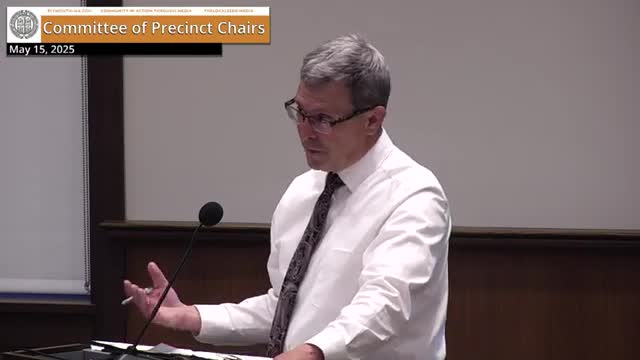Plymouth Board Examines Affordable Housing Units and Density Challenges
May 16, 2025 | Town of Plymouth, Plymouth County, Massachusetts
This article was created by AI summarizing key points discussed. AI makes mistakes, so for full details and context, please refer to the video of the full meeting. Please report any errors so we can fix them. Report an error »

The Plymouth Committee of Precinct Chairs convened on May 15, 2025, to discuss critical issues surrounding local housing development and affordable housing strategies. The meeting highlighted ongoing concerns about the density of new housing projects and the implications for the town's affordable housing goals.
A significant topic of discussion was a proposed development project primarily focused on single-family homes. Committee members expressed concerns about the potential density of this project, which could necessitate a wastewater treatment plant and the use of private wells. The developer is currently approved for 60 units under a planning board special permit, which includes six affordable units. However, there are rumors that the project could expand to as many as 400 units, raising questions about the number of affordable homes that would be required.
The committee also examined the town's current affordable housing percentage, which stands at 10%. Members discussed the challenges of increasing this percentage, particularly in light of the financial burdens placed on developers. It was noted that while Plymouth has been fortunate with developer cooperation on affordable units, increasing the percentage to 20% would likely require higher density developments, which could conflict with community desires for lower-density neighborhoods.
Another point raised was the impact of the upcoming 2030 census on the town's housing calculations. The committee acknowledged that the denominator used to calculate the affordable housing percentage—total year-round housing—could increase faster than the numerator, which represents the number of affordable units. This could complicate efforts to maintain or improve the town's affordable housing status.
Overall, the meeting underscored the ongoing tension between the need for affordable housing and community preferences for lower-density developments. As Plymouth prepares for future housing demands, the committee will need to navigate these challenges carefully to meet both community and housing needs.
A significant topic of discussion was a proposed development project primarily focused on single-family homes. Committee members expressed concerns about the potential density of this project, which could necessitate a wastewater treatment plant and the use of private wells. The developer is currently approved for 60 units under a planning board special permit, which includes six affordable units. However, there are rumors that the project could expand to as many as 400 units, raising questions about the number of affordable homes that would be required.
The committee also examined the town's current affordable housing percentage, which stands at 10%. Members discussed the challenges of increasing this percentage, particularly in light of the financial burdens placed on developers. It was noted that while Plymouth has been fortunate with developer cooperation on affordable units, increasing the percentage to 20% would likely require higher density developments, which could conflict with community desires for lower-density neighborhoods.
Another point raised was the impact of the upcoming 2030 census on the town's housing calculations. The committee acknowledged that the denominator used to calculate the affordable housing percentage—total year-round housing—could increase faster than the numerator, which represents the number of affordable units. This could complicate efforts to maintain or improve the town's affordable housing status.
Overall, the meeting underscored the ongoing tension between the need for affordable housing and community preferences for lower-density developments. As Plymouth prepares for future housing demands, the committee will need to navigate these challenges carefully to meet both community and housing needs.
View full meeting
This article is based on a recent meeting—watch the full video and explore the complete transcript for deeper insights into the discussion.
View full meeting
